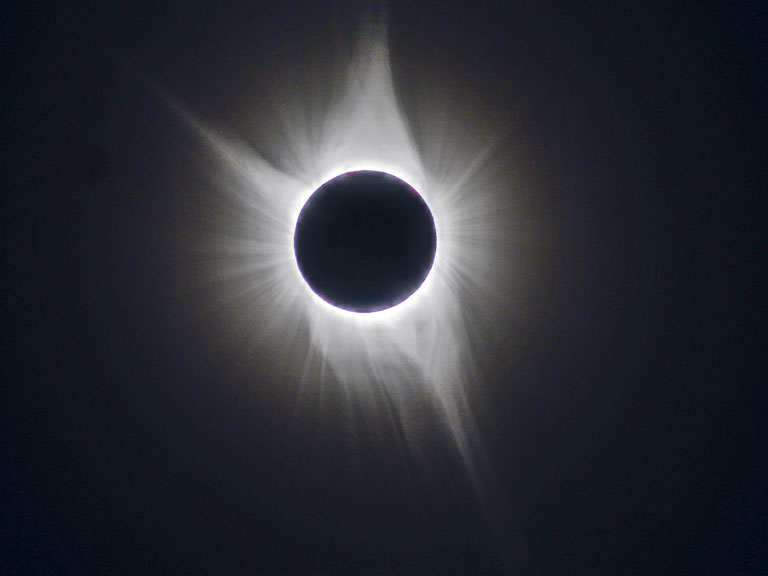County News
Beneath the shadow of the moon

Rare solar eclipse will cover the County in darkness
The spectacle of a solar eclipse is nothing short of magnificent, and County residents will be treated to this rare event on April 8. A solar eclipse occurs when the moon passes directly in front of the sun. As the moon blots out the last remaining sliver of sunlight, the sky takes on the aura of twilight, and for several minutes stars and planets can be seen in the daytime sky. But the real jewel is the sun itself, or rather the “atmosphere” of the sun, which is normally overwhelmed by our home star’s brightness. There’s the ruby-red chromosphere that will be visible as a ring of light around the silhouette of the moon. Stretching several degrees around the sun is the ethereal pearl-white corona, a region of diffuse but ultra hot gas that traces the sun’s magnetic field. As the 11-year solar activity cycle is nearing its maximum, there’s the possibility of a lot of detail in the chromosphere and corona. This phase of the eclipse lasts only a few minutes, but it is why aficionados will travel the world to experience totality.
Last Saturday afternoon, members of the Belleville branch of the Royal Astronomical Society of Canada (RASC) gave a presentation at the Picton Library on what to expect in April’s total eclipse. The event was scheduled for 2 p.m., but so many people showed up— well beyond the capacity of the room— that it was repeated again at 2:45. It was led by Donald Town, co-president of the Belleville RASC. He has been an amateur astronomer for over 30 years, and his presentation was both informative and entertaining. He explained that the moon’s orbit is very slightly tilted to the earth’s orbital plane, meaning that eclipses can only occur when the alignment is perfect. During a lunar eclipse, the earth’s shadow— which is quite large—can easily cover the moon. The moon’s shadow on the earth, however, is just a few hundred kilometres wide at most, meaning that only a limited area will experience a solar eclipse. Add to this the fact the moon can be at varying distances from the earth, and so total eclipses at any particular location are few and far between. The last total solar eclipse visible from the County was in 1349; the next one after this will be in 2399.
Mr. Town spoke at length about eye safety during an eclipse. The partial phases of the eclipse—where the moon is gradually covering the sun—can only be viewed using a proper filter that reduces the amount of light by a factor of 100,000. Ordinarily, people can take a quick glimpse of the sun with no ill effect.
But during an eclipse there’s the temptation to look for several seconds, and that will be enough to burn the retina. There are no pain sensors in the retina to warn of impending damage, so “eclipse blindness” is a very real danger. Eclipse glasses are available from a number of online retailers— just make sure they are ISO certified. He noted there are indirect ways to look at the eclipse, such as building a pinhole projection box, using what is known as a pinhole mirror to cast an image onto a shadowed wall, or even using a colander. There are special filters available for safe observation through binoculars or a telescope. The only time that filters are not necessary is during the few minutes of totality.
This April’s eclipse traces a narrow path of totality from the Pacific just west of Mexico, diagonally across North America through Newfoundland and ends in the north Atlantic. Outside of this area, the eclipse will just be partial, with the moon only covering a portion of the sun. The difference between a partial and total eclipse is literally the difference between night and day— even a 99 per cent eclipse is still too bright. The County is well placed for viewing, with about 3 minutes of totality in Picton beginning at 3:20 p.m.. Belleville gets a paltry 2 minutes, while Point Petre, which is closer to the centerline gets 3 minutes and 24 seconds. The full eclipse sequence begins just after 2 p.m. and goes to about 4:30. The big factor, however, is the weather. The probability of cloudy weather on that day is around 60 per cent. Eclipse chasers will travel thousands of kilometres to improve their odds of clear sky. For this one, the Mexican desert seems to be the best bet. But in any regard, it’s a gamble. Mr. Town said that the best thing to do during a total eclipse is just to enjoy and savour the experience. It really is a once-in-a-lifetime experience for the vast majority. Those who have caught the eclipse bug, well, they will find a way to scratch that itch. Please visit timeanddate.com and follow the Eclipse tab to find an interactive map that will give exact times for you location.

Comments (0)